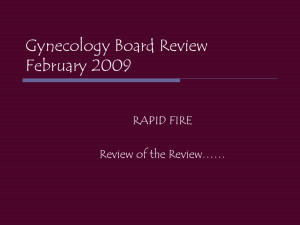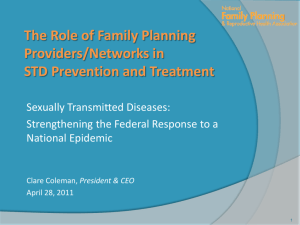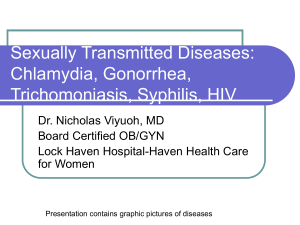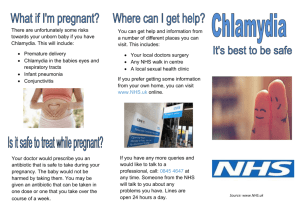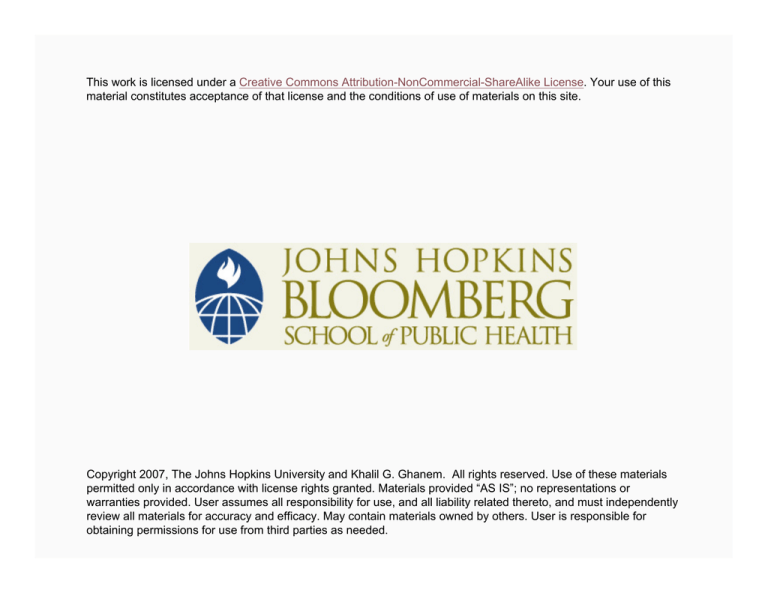
This work is licensed under a Creative Commons Attribution-NonCommercial-ShareAlike License. Your use of this
material constitutes acceptance of that license and the conditions of use of materials on this site.
Copyright 2007, The Johns Hopkins University and Khalil G. Ghanem. All rights reserved. Use of these materials
permitted only in accordance with license rights granted. Materials provided “AS IS”; no representations or
warranties provided. User assumes all responsibility for use, and all liability related thereto, and must independently
review all materials for accuracy and efficacy. May contain materials owned by others. User is responsible for
obtaining permissions for use from third parties as needed.
Chlamydia Trachomatis and Neisseria
Gonorrhoeae
Khalil G. Ghanem, MD
Johns Hopkins University
A Brief Aside
Several of the pictures used in this talk are not my own, but those
of individuals who, over the years, have kindly given me copies to
use
Occasionally, some were obtained from the internet
The figures and charts in the epidemiology section are from the
2005 CDC STD Surveillance Report which can be found at the
following URL:
− http://www.cdc.gov/std/stats/trends2005.htm
3
Section A
Chlamydia Trachomatis
Chlamydia Trachomatis: Pathogenesis
Obligate intracellular bacterium
Has DNA and RNA, bacterial ribosomes, gram-negative-like cell wall
Deficient in endogenous ATP production
Has a dimorphic developmental cycle, which happens in an
intracellular cytoplasmic inclusion
Susceptible to antibiotics
5
Serological Classification
A,B, Ba, C (Trachoma)
D-K (genitourinary and ocular infections)
L1-L3 (lymphogranuloma venereum)
6
Clinical Manifestations (D-K Serotypes): Men
Urethritis
− Discharge classically
− may be asymptomatic
Epididymitis
− 70% due to CT
7
Clinical Manifestations (D-K Serotypes): Women
Cervicitis
Majority—no signs or symptoms
If present, signs include . . .
− Discharge, ectopy, edema, induced bleeding
30-50% have mucopurulent cervicitis (>30 PMNs per oil
immersion field)
Pelvic Inflammatory Disease (PID)
8
Clinical Manifestations: Men and Women
Proctitis
Caused by direct inoculation from unprotected anal sex
Serovar D-K or LGV types
Symptoms may include . . .
− Rectal bleeding and pain
− Mucous discharge
− Diarrhea
9
Lymphogranuloma Venereum
Worldwide distribution but higher prevalence in tropical and
subtropical regions
Endemic in Africa, India, SE Asia, the Caribbean, and Brazil
Strains are more invasive
Cause thrombolymphangitis
Early disease—transient genital ulcer, buboes, inflammation;
rectal pain/bleeding
Late disease—abscesses, fistulas, genital elephantiasis, frozen
pelvis, and rectal strictures
10
Trachoma: Serovars A, B, Ba, C
Trachoma is a chronic keratoconjunctivitis
Active disease occurs most commonly in preschool-aged children,
with the highest prevalence in those children three to five years old
Disease transmission occurs primarily between children and the
women who care for them
Repeated episodes of reinfection within the family cause chronic
follicular conjunctival inflammation (active trachoma) resulting in
corneal abrasions, corneal scarring and, ultimately, blindness
Most common cause of preventable blindness worldwide
In the U.S.
− Endemic once in North America and Europe but has disappeared
with improved living standards
Internationally
− Trachoma is endemic in Africa, Asia, the Middle East, and
Aboriginal communities in Australia
− Worldwide, 360 million people are affected
11
Chlamydia: Diagnosis
Cell culture—sensitivity no more than 80% and “invasive”
Non-amplified molecular tests (EIA, DFA) sensitivity up to 85%
Amplified molecular tests [nucleic acid amplification tests (NAATs)]
− Gold standard; can be performed on genital swabs (cervical,
urethral, or vaginal) and on urine (i.e., less “invasive”)
− Sensitivity > 90%
Introduced in the mid 1990s
Interesting Question: How do we assess diagnostic accuracy of a test
that is more sensitive than the gold standard?
12
Section B
Chlamydia Trachomatis: Epidemiology
Overview
Most commonly reported infectious disease in the U.S. (976,445
cases reported in 2005 to the CDC)
“Approximately 5%-14% of routinely screened females aged 16-20
years and 3%-12% of women aged 20-24 years are infected with
chlamydia”
335 commercial health maintenance organizations (HMOs) and
point-of-service (POS) plans and 92 Medicaid HMO and POS plans
reported chlamydia screenings
These data accounted for 83% of enrollees in commercial HMO and
POS plans and up to 30% of enrollees in Medicaid HMO and POS plans
in the United States during this period MMWR October 29,
2004/53(42); 983-985
14
Chlamydia Rates: United States, 1986–2005
The 2005 rates for the United States were calculated by dividing the
number of cases reported from each area in 2005 by the estimated
area-specific 2004 population
STD Surveillance 2005. CDC.
15
Need Title
Adam/Andy can you please give me a title for this slide?
Note—trends adjusted for changes in laboratory test method and
associated increases in test sensitivity
Source: Regional Infertility Prevention Projects. CDC.
16
Chlamydia Rates by Region
STD Surveillance 2006. CDC.
17
Chlamydia Rates by Race
STD Surveillance 2006. CDC.
18
Female Chlamydia Rates, 2005
Cases per 100,000 P opulation
3500
3000
2500
2000
1500
1000
500
0
10 to 14
15 to 19
20 to 24
25 to 29
30 to 34
35 to 39
40 to 44
45 to 54
55 to 64
65+
Age
19
Epidemiology: Summary
The increase in reported chlamydia infections during the last 10
years is due to the following:
− The expansion of chlamydia screening activities
− Increasingly sensitive diagnostic tests
− Increasing emphasis on case reporting from both providers and
laboratories
− Improvements in the information systems for reporting
Chlamydia screening and reporting are likely to expand further in
response to the recently implemented Health Plan Employer Data
and Information Set (HEDIS) measure for chlamydia screening of
sexually active women 15 through 25 years of age who receive
medical care through managed care organizations
20
FYI: CDC Reporting
Reporting of Chlamydia Cases
“Trends in chlamydia morbidity reporting from many areas are more
reflective of changes in diagnosis and reporting of cases rather than
actual trends in disease incidence. Cases and rates of reported
chlamydia in sex-specific tables are underestimated due to some
reported cases with unknown sex. Despite problems with underreporting, it is important to publish available data to emphasize the
large numbers of cases of chlamydia being detected in the United
States. As areas develop chlamydia prevention and control
programs, including improved surveillance systems to monitor
trends, the data should improve and become more representative of
true trends in disease.”
Source: CDC STD Surveillance 2005: Appendix
21
Section C
Chlamydia Trachomatis: Treatment and Screening
Recommended Regimens: CT
Recommended Regimens
Azithromycin 1 g PO or . . .
Doxycycline 100 mg PO BID for seven days
Alternative Regimens
Seven day course of . . .
− Erythromycin base 500 mg PO QID or . . .
− Erythromycin ethylsuccinate 800 mg QID or . . .
− Ofloxacin 300 mg PO BID
23
Other Considerations for Chlamydia Treatment
Re-screen women for CT three to
four months after treatment
Screen sexually active women
< = 25 years-old and high-risk
women > 25 years old
Refer all sex partners in the last
60 days for evaluation, testing,
and therapy
No sex until patient AND
partner/partners are cured
24
Chlamydia Trachomatis: Infection and Re-Infection in
12-19 Year-Old Adolescent Women
3,202 sexually active women followed for 33 months
Chlamydia infection in 24% of 1st visits and 14% of repeat visits
Median time positive test
− 1st positive—7.2 months
− Repeat positive—6.3 months
Screen sexually active adolescent females every six months
Source: Burstein, et al. (1998). JAMA; 280: 521-526
25
Does Screening Lead to Better Outcomes?
Prospective study in group health, Seattle
− 2,607 reproductive-age women
− From 1990–1992 (did not use NAATs)
− 1,009 randomized to screening intervention (but only 645 got
tested)
− 1,598 usual care (no active intervention)
− Outcome—number of cases of PID in each group (ITT analysis)
Source: Scholes, D., NEJM (1996); 334: 1362-1366
26
Prevention of PID: Screening for Chlamydial Infection
Number of
Cases of PID
Screening
Usual Care
Odds Ratio
9
33
0.42
(0.20-0.89)
Per 10,000 woman-months
O.R. adjusted—age, marital status, douching
Source: Scholes, D. et al. (1996). NEJM, 334: 1362-1366
27
Section D
Neisseria Gonorrhea
Neisseria Gonorrhoeae (GC)
Gram-negative diplococcus
Fastidious—requires hemoglobin, CO2
Only causes disease in humans
− No animal host
Causes infection in columnar epithelial surfaces
Multiple types—implications for vaccine
29
Gonococcal Syndromes
Men—urethritis, epididymitis
Women—cervicitis, salpingitis
Men and women—proctitis, pharyngitis
Newborns—ophthalmia, pneumonia
Unusual—disseminated infection, adult ophthalmia, endocarditis,
meningitis
30
Urethritis and Cervicitis
Urethritis
Mostly seen in men [although
urethritis may accompany
cervicitis in women (~30%)]
Symptoms—discharge of pus from
the urethra & dysuria (pain on
urination).
Purulent discharge seen in > 80%
of men with GC urethritis
Cervicitis
30-50% of women may be
asymptomatic
Symptoms—discharge, pruritus
(itching), lower abdominal pain,
dysuria, dyspareunia (painful
intercourse)
Several other diseases can mimic
GC symptoms—chlamydia, herpes,
trichomoniasis, BV, MPC
31
GC and HIV
Retrospective and prospective
studies demonstrate increased risk
of HIV TRANSMISSION (HIV viral
load in semen of GC infected men
increases dramatically) and . . .
ACQUISITION (increased number of
immune cells in presence of GC
infection)
What are some potential problems
with these studies?
1. Behavioral confounding
2. Selection bias
3. Temporal bias
− Think about other different
types of biases in
retrospective and prospective
studies
32
GC Diagnosis
Gram’s stain has about 90% sensitivity in SYMPTOMATIC men
− Sensitivity much lower in symptomatic women (~50%) and
asymptomatic men and women (< 50%)
− Specificity is about 95% in men, but lower in women
Culture is still the gold standard; sensitivity > 90% and specificity
> 99% (gender differences in sensitivity)
Non-amplified molecular tests (EIA, etc.)
Amplified molecular tests—NAATs (not FDA cleared for rectal and
oropharyngeal samples)
33
Symptoms (or Lack of Symptoms)
90
Percent Asymptomatic
80
70
60
Men
Women
50
40
30
20
10
0
Urethra
Rectum
Gonorrhea
Pharynx
Cervix
Rectum
Urethra
Chlamydia
Any
Herpes
34
Section E
The Epidemiology of Neisseria Gonorrhoeae
Overview
Gonorrhea is the second most commonly reported notifiable disease
in the United States (339,593 cases reported to the CDC in 2005)
From 1975-1997, U.S. gonorrhea rates declined 74.3% following
implementation of the national gonorrhea control program in the
mid-1970s
However, in 2005, rates increased slightly from 2004
Rate increases or decreases may be masked by the following:
− Changes in screening practices (affected by simultaneous
testing for chlamydia)
− Use of diagnostic tests with different sensitivities
− Changes in reporting practices
36
Gonorrhea Rates: United States 1941–2005 and the
Healthy People 2010 Target
STD Surveillance 2006. CDC
37
Gonorrhea Rates by State: United States (2005)
STD Surveillance 2006. CDC
38
Gonorrhea Rates by Sex: United States, 1986–2005
STD Surveillance 2006. CDC
39
Gonorrhea Rates by Race and Ethnicity: U.S., 1981–2004
STD Surveillance 2006. CDC
40
Gonorrhea Positivity by Age
STD Surveillance 2006. CDC
41
Section F
Neisseria Gonorrhoeae: Treatment and Drug Resistance
Therapy for Uncomplicated GC of the Cervix, Urethra
and Rectum
Cefixime 400 mg orally
Ceftriaxone 125 mg intramuscular
Ciprofloxacin 500 mg orally
Ofloxacin 400 mg orally
PLUS
Doxycycline 100 mg orally twice a day x 1 week OR Azithromycin 1
gm orally x1
43
Partner Treatment Modalities
None
DIS (disease intervention specialists)
Patient initiated REFERRAL of partners
Novel method—patient initiated TREATMENT of partners
Source: Golden, et al. (2005). N Engl J Med. Feb 17; 352(7):676-85
44
Antimicrobial Resistance
STD Surveillance 2005. CDC
45
Quinolone Resistant Gonorrhea (QRNG)
Rapidly increasing—especially in the Pacific Basin
Change in treatment guidelines for the West Coast
Quinolones recommended only since 1989
Probably due to antibiotic overuse/misuse
46
Fluoroquinolone-Resistant Strains in the U.S.
STD Surveillance 2005. CDC
47
GC: Summary of Major Epidemiological Trends
Gonorrhea maintained in core groups
Disproportionate impact on minorities
Increases in gay men
Emerging quinolone resistance
“Repeater” impact
Facilitate HIV infection
48
Future GC Issues that Need to be Addressed
How much longer can we use fluoroquinolones?
Will NAATs become the “new” gold standard in diagnosing neisseria
gonorrhoeae?
How will we follow susceptibility patterns of the organisms without
culture testing?
Where’s the vaccine?
49


